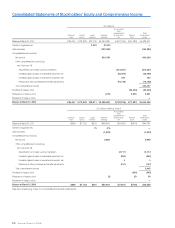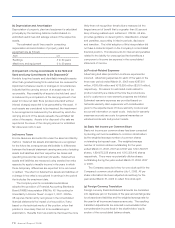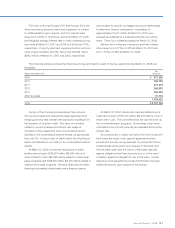Honda 2008 Annual Report Download - page 73
Download and view the complete annual report
Please find page 73 of the 2008 Honda annual report below. You can navigate through the pages in the report by either clicking on the pages listed below, or by using the keyword search tool below to find specific information within the annual report.
A n n u a l R e p o r t 2 0 0 8 7 1
Foreign currency receivables and payables are translated
at the applicable current rates on the balance sheet date. All
revenues and expenses associated with foreign currencies
are converted at the rates of exchange prevailing when such
transactions occur. The resulting exchange gains or losses
are reflected in other income (expense) in the consolidated
statements of income.
Foreign currency transaction gains (losses) included in
other income (expenses)—other for each of the years in the
three-year period ended March 31, 2008 are as follows:
Yen
(millions)
U.S. dollars
(millions)
(note 2)
2006 2007 2008 2008
¥(38,880) ¥(48,261) ¥2,895 $29
(q) Derivative Financial Instruments
Honda has entered into foreign exchange agreements and
interest rate agreements to manage currency and interest
rate exposures. These instruments include foreign currency
forward contracts, currency swap agreements, currency
option contracts and interest rate swap agreements.
Honda recognizes at fair value all derivative financial
instruments in its consolidated balance sheets. Derivative
asset and liability positions are presented net by
counterparty on the consolidated balance sheets when valid
master netting agreement exists and the other conditions
set out in Financial Accounting Standards Board (FASB)
Interpretation (FIN) No. 39, “Offsetting of Amounts Related to
Certain Contracts” are met.
The Company applies hedge accounting for certain
foreign currency forward contracts related to forecasted
foreign currency transactions between the Company and its
subsidiaries. These are designated as cash flow hedges on
the date derivative contracts are entered into. The Company
has a documented currency rate risk management policy.
In addition, it documents all relationships between derivative
financial instruments designated as cash flow hedges
and the relevant hedged items to identify the relationship
between them. The Company assesses, both at the hedge’s
inception and on an ongoing basis, whether the derivative
financial instruments designated as cash flow hedge are
highly effective to offset changes in cash flows of hedged
items.
When it is determined that a derivative financial
instrument is not highly effective as a cash flow hedge, when
the hedged item matures, is sold or is terminated, or when
it is identified that the forecasted transaction is no longer
probable, the Company discontinues hedge accounting.
To the extent derivative financial instruments are designated
as cash flow hedges and have been assessed as being
highly effective, changes in their fair value are recognized
in other comprehensive income (loss). The amounts are
reclassified into earnings in the period when forecasted
hedged transactions affect earnings. When these cash flow
hedges prove to be ineffective, changes in the fair value of
the derivatives are immediately recognized in earnings.
Changes in the fair value of derivative financial
instruments not designated as accounting hedges are
recognized in earnings in the period of the change.
The amount recognized in earnings included in
other income (expenses)—other during the years ended
March 31, 2006, 2007 and 2008 are ¥55,516 million loss,
¥48,485 million loss and ¥48,746 million ($487 million) gain,
respectively. In relation to this, the Company included gains
and losses on translation of debts of finance subsidiaries
denominated in foreign currencies intended to be hedged
of ¥45,046 million gain, ¥8,351 million loss and ¥118,997
million ($1,188 million) loss in other income (expenses)—other
during the years ended March 31, 2006, 2007 and 2008,
respectively. In addition, net realized gains and losses on
interest rate swap contracts not designated as accounting
hedges by mainly finance subsidiaries of ¥827 million gain,
¥3,309 million gain and ¥10,550 million ($105 million) loss are
included in other income (expenses)—other during the years
ended March 31, 2006, 2007 and 2008, respectively. These
gains and losses are presented on a net basis.
Honda doesn’t hold any derivative financial instruments
for trading purposes.
(r) Shipping and Handling Costs
Shipping and handling costs included in selling, general and
administrative expenses for each of the years in the three-
year period ended March 31, 2008 are as follows:
Yen
(millions)
U.S. dollars
(millions)
(note 2)
2006 2007 2008 2008
¥181,675 ¥219,361 ¥239,737 $2,393
(s) Asset Retirement Liability
Honda recognizes an asset retirement liability if the fair
value of the obligation can be reasonably estimated. Asset
retirement obligations include those for which an entity has
a legal obligation to perform an asset retirement activity,
however, the timing and (or) method of settling the obligation
are conditional on a future event that may or may not be
within the control of the entity.
(t) New Accounting Pronouncements
In September 2006, the Financial Accounting Standards
Board (FASB) issued Statement of Financial Accounting
Standards (SFAS) No. 157, “Fair Value Measurements”.
This statement defines fair value, establishes a framework
























